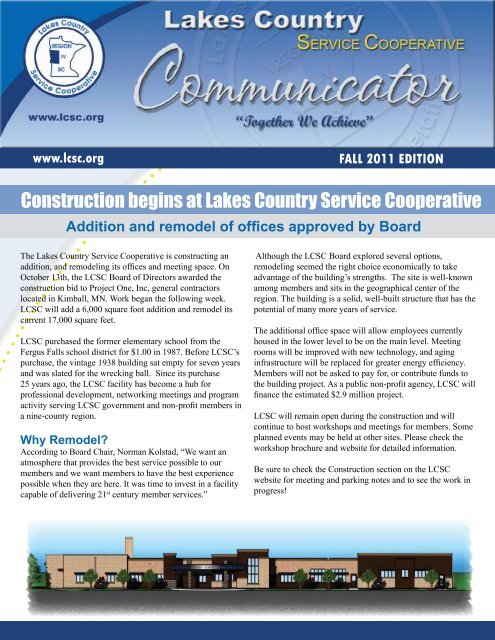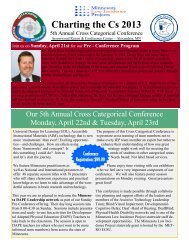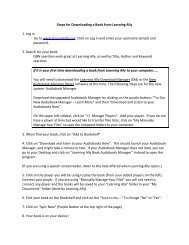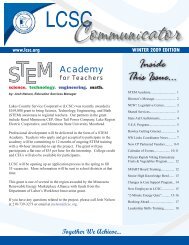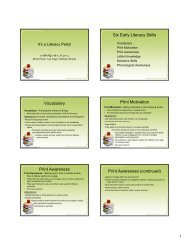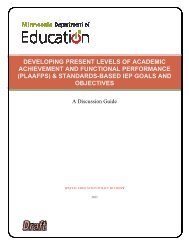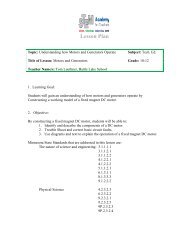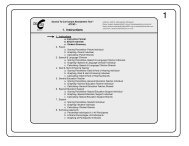Download - Lakes Country Service Cooperative
Download - Lakes Country Service Cooperative
Download - Lakes Country Service Cooperative
- No tags were found...
Create successful ePaper yourself
Turn your PDF publications into a flip-book with our unique Google optimized e-Paper software.
www.lcsc.orgFALL 2011 EDITIONConstruction begins at <strong>Lakes</strong> <strong>Country</strong> <strong>Service</strong> <strong>Cooperative</strong>Addition and remodel of offices approved by BoardThe <strong>Lakes</strong> <strong>Country</strong> <strong>Service</strong> <strong>Cooperative</strong> is constructing anaddition, and remodeling its offices and meeting space. OnOctober 13th, the LCSC Board of Directors awarded theconstruction bid to Project One, Inc, general contractorslocated in Kimball, MN. Work began the following week.LCSC will add a 6,000 square foot addition and remodel itscurrent 17,000 square feet.LCSC purchased the former elementary school from theFergus Falls school district for $1.00 in 1987. Before LCSC’spurchase, the vintage 1938 building sat empty for seven yearsand was slated for the wrecking ball. Since its purchase25 years ago, the LCSC facility has become a hub forprofessional development, networking meetings and programactivity serving LCSC government and non-profit members ina nine-county region.Why Remodel?According to Board Chair, Norman Kolstad, “We want anatmosphere that provides the best service possible to ourmembers and we want members to have the best experiencepossible when they are here. It was time to invest in a facilitycapable of delivering 21 st century member services.”Although the LCSC Board explored several options,remodeling seemed the right choice economically to takeadvantage of the building’s strengths. The site is well-knownamong members and sits in the geographical center of theregion. The building is a solid, well-built structure that has thepotential of many more years of service.The additional office space will allow employees currentlyhoused in the lower level to be on the main level. Meetingrooms will be improved with new technology, and aginginfrastructure will be replaced for greater energy efficiency.Members will not be asked to pay for, or contribute funds tothe building project. As a public non-profit agency, LCSC willfinance the estimated $2.9 million project.LCSC will remain open during the construction and willcontinue to host workshops and meetings for members. Someplanned events may be held at other sites. Please check theworkshop brochure and website for detailed information.Be sure to check the Construction section on the LCSCwebsite for meeting and parking notes and to see the work inprogress!
From the desk of the director...Jeremy KovashExecutive DirectorBill Blazar, Executive Director of the Minnesota Chamber ofCommerce recently spoke to our school leaders. “Public <strong>Service</strong>sto Match a World Economy” was the focus of his presentation.As a former history teacher, I found it interesting to hear Blazar’stake on the regionalism of the 1970’s versus the globalization oftoday.Workforce is a driver of the economy. In Minnesota, womenentering the workforce in large numbers led to much of oureconomic growth in the 1970’s and 1980’s. As the percentage ofworking women has peaked, and the population ages, that growthhas slowed and will almost cease in upcoming decades. By 2030we will have more dependent elderly citizens than youth. Inaddition, the achievement gap has hurt workforce growth as well.Currently, 13% of Minnesota’s students speak a non-English language at home. From2006 to 2020, Minnesota’s population from age 5 to 24 years will change ascurrent minority groups will increase from 24-34% and the white populationdecreases by 7%. Clearly, it benefits everyone to support the work of ourschool community to close the achievement gap. These populationchanges have, and will continue to have a huge impact on oureconomy.At LCSC, we don’t just talk about and plan for redesign as we arechartered to do ~ we make change happen. We work with our membersto redesign and improve public service and delivery to meet the economicchallenges ahead. We work with our members to redesign governance. Theseworks are evident as we’ve facilitated the vital work of our members for manyyears. Most recently, several of our cities have joined together to share a buildingofficial through LCSC. With our schools, we’ve built an award winning modelredesigning business governance.We are proud of our work with redesign and will continue to facilitate this growth with ourbroad and diverse membership. We hope you enjoy this issue of “The Communicator.”Together we achieve…2
Legislative CornerGUEST AUTHOR: Bill Strusinski, Legislative AdvocateWhen the legislature convenes the 2012session on January 24th, it will be fastpaced and the decisions they make willcontinue to affect the lives of everyMinnesotan. Key issues that will beaddressed include: a stadium for theVikings, Racinos, Casinos; bonding forcapital investment projects; jobs; budgetcuts; taxes; education; health care; andstate government reform. Under theState Constitution, this is supposed tobe a short session that deals primarilywith policy as opposed to budget and tax issues. However, not all ofthe major fiscal work was completed during the last session and thespecial session that ended a state government shutdown in July.Let me set the stage by saying that the state’s budget continues, justlike the federal government, to be plagued by fiscal problems. Thereis a lot of speculation that the November budget forecast will project ashortfall in the range of $500M. A budget shortfall of that magnitudewould be problematic since there are fewer months remaining inthe biennial budget cycle to make up the shortfall. The economicmodel supporting the State of Minnesota budget is premised onwhat is happening on the national level. As the national economyis still performing below expectations, so is our state’s economy.Unemployment remains high both on a national and state level whichcontributes significantly to a dismal forecast.As in 2011, the legislature will not be raising taxes to make up theshortfall which means that more cuts are on the horizon. Specifically,there will be no money to buy back the education budget shift andsignals possible further cuts to education and Local Government Aids(LGA). As in the past look for short-term solutions which will leavelong term problems.Government reform is now being looked at as a panacea to addressthe long term structural budget problems. Besides passing severalreform initiatives in 2011, the legislature has created a REFORMTASKFORCE to further focus on the issues of how governmentservices are delivered. Unfortunately, such reforms will not occur andgenerate enough savings to balance the current biennial budget. So,it would be wise to again prepare for more cuts and possibly morebudget shifts.Will the legislature raise taxes? In a word, NO. Politically, thereis too much at stake. The Republicans control both the House andSenate and continue to pledge to cut spending as opposed to raisingtaxes. I expect the political stalemate to continue through the 2012session.Of course, the legislature could do nothing and let the Governor makeall of the budget decisions. Should the legislature adjourn withoutaddressing any budget shortfalls, the Governor would be forced to“unallot” spending so as to balance the budget. In other words, theGovernor will make all of the spending reduction decisions that arerequired to balance the budget by the end of the biennium which isJune 30, 2013. We have been down that road before and it is not apretty process and has led to court challenges and great anxiety.Another major focus will be a state capital investment bill whichwill provide bond funds for state and local building construction andrenovation projects. The current state bond level capacity allowsfor a bill in the magnitude of $775M. A bonding bill of this sizewill definitely have an impact in helping stimulate the constructioneconomy which has been more dramatically affected than the rest ofthe economy. However, I believe it will take a much smaller bill togather the votes necessary to pass the legislature.While the stadium for the Vikings and major budget problems willcontinue to capture the limelight this session, there is an opportunityfor the legislature to deal with some of the unfinished policy businessheld over from last session. Other such issues include: Health CareReform, Education Reform and more shared services, and possiblylocal government tax policy reform. The Governor has appointed atask force to help set up a state health care exchange as required underthe new national health care law. With respect to education funding,Rep Garafalo, the Chair of the House Education Finance Committeesaid he will introduce a bill that would require local school levy votesto be held only in the even number year when the major electionsoccur. His reasoning is to provide more transparency and more voterparticipation. Other bills will be acted on that will allow more localgovernment and possibly business collaborations on such issues asenergy, technology and health care.You should also expect final floor action in the House ofRepresentatives on the PEIP Bill which passed the State Senate lastsession. This legislation would basically require collective bargainingunits to negotiate the right to leave the local health insurance plan forthe State operated Public Employee Insurance Plan. Under currentlaw, the collective bargaining unit can unilaterally make the decisionto leave local insurance plans.As a final point, let’s not forget the role politics will play in the 2012session. At the end of session, the political stage will be set and theideas and the rhetoric coming out of the 2012 session will be theprelude to this fall’s election cycle. The entire legislature is up for reelectionthis year. And as required by the Constitution, they will runin new districts based on the 2010 census. Two different philosophicalapproaches will be once again put before the voters on how best tomove Minnesota forward in the future. This most important eventwill allow you to express your own opinion by voting for candidatesyou believe will do the best job in dealing with the major issues facingall of us. I urge you to pay close attention to the dialogue and be sureto participate in the process. Be prepared to get engaged on issues thissession and participate in the elections next fall.3
Reading well by 3rd Gradeby: Sarah Suchy, AYP CoordinatorLast winter, Governor Dayton and Minnesota’s Education Commissioner, Brenda Casellius, partneredtogether to share their education plan, “Better Schools for a Better Minnesota.” Goals of thisdocument focus on building a strong, high achieving state of learning for all students, includingthose ages pre-kindergarten through seniors. Work has already started on this plan to bridge the gapbetween early childhood education and the elementary setting. Another endeavor already evidentfocuses on building a stronger system where all students are reading well by third grade.This past April, the United States Secretary of Education, Arne Duncan, shared, “Weknow that high-quality early childhood programs are one of the best investments we canmake on a child’s future.” This key belief as well as the numerous studies on the return oninitial investment for early childhood education to districts as well as society has lead Minnesota down a path to educatestakeholders on ways to strengthen their own early childhood support. Twice this summer, the Minnesota Departmentof Education shared various strategies in bridging the early childhood and elementary setting gap. This work includesfostering community partnerships with all early childhood educators to provide high quality professional developmentto both sets of educators and assess and track students to located trends. Reflecting and learning from all communitystakeholders, including the public school system, will help to bridge the gap between these two worlds.Complementing the work to bridge early childhood and the K-12 system is the initiative for all students to be reading wellby third grade. Legislation passed last summer requires all districts to create a Local Literacy Plan to address how schoolswill work to have all readers reading well by third grade. Coupled with this plan is the reward system for students whoare meeting proficiency and have high growth in grades 3 and 4. Beginning next year, each school will have a proficiencyallowance based on those who meet or exceed proficiency in third grade and make medium or high growth on the fourthgrade assessments.An open invitation for great opportunities for your studentsby: Susan Ward, Academic Challenges CoordinatorIf your school is not participating in the Knowledge Bowl and Spelling Bee programs offered through LCSC, here is your chance toemphasize academics and provide your students the opportunity to demonstrate their academic abilities through competitions withother schools in the region and state.The junior high and senior high Knowledge Bowl programs foster recall, critical thinking, cooperation and problem solving skills asstudents work in teams to answer questions in a variety of academic areas.The Spelling Bee program encourages students in grades five through eight to study language concepts and patterns, resulting inenriched vocabulary and language development.A student from your district may win an all-expense paid trip to Washington, D.C. or bring home the State Knowledge Bowl trophy.Regardless of the prize, all students participating in these academic programs benefit from the opportunity.Please contact Susan Ward at sward@lcsc.org or program assistants Monica Thompson at mthompson@lcsc.org,Jolene King at jking@lcsc.org, or call 218-739-3273 for more information.4
5th Annual Western Minnesota Schools Collaborative In-<strong>Service</strong>Educators Working Togetherby: Scott Monson, Morris Area Schools SuperintendentNine school districts – Browns Valley, Chokio-Alberta,Clinton-Graceville-Beardsley, Cyrus, Hancock, Herman-Norcross, Morris Area, West Central Area, and WheatonArea, along with the Midwest Special Education<strong>Cooperative</strong> and St. Mary’s School worked togetherand held the Fifth Annual Western Minnesota SchoolsCollaborative In-<strong>Service</strong>. This event took place onWednesday, August 24 at the Morris Area Schools.The in-service involved nearly 600 staff membersrepresenting several communities and in excess of 3,100students who attend school in Western Minnesota!During this in-service, ALL employees (teachers, cooks,custodians, paraprofessionals, administrators, bus drivers,office staff, community education staff, technologycoordinators, etc.) from participating educationalorganizations were brought together for a productive,informative, and motivating day.After a brief welcome, licensed staff members attendeda re-licensure session of their choice or a wellnesspresentation from Ann Dolence, <strong>Lakes</strong> <strong>Country</strong> <strong>Service</strong><strong>Cooperative</strong>. Licensed staff then met by grade or subjectarea for a facilitated session with their peers. Nonlicensedstaff members met in job-alike groups for mandatory andother training and valuable information sharing. <strong>Lakes</strong><strong>Country</strong> <strong>Service</strong> <strong>Cooperative</strong> Health and Safety FacilitatorsPaula Pederson and Brad Schmidt presented employeeright-to-know and blood borne pathogen training to allstaff in attendance. After a short break for lunch, formernational teacher of the year, Guy Doud, gave a “Molderof Dreams” keynote speech that had audience memberslaughing, crying, and everything in between.“Having our staff be able to work with and collaboratewith others in similar positions provides the wonderfulopportunity to share ideas and strategies that workin classrooms with the goal of increasing studentachievement,” stated West Central Area SuperintendentPat Westby.Morris Area Superintendent Scott Monson commentedthat “<strong>Lakes</strong> <strong>Country</strong> <strong>Service</strong> <strong>Cooperative</strong> continues to bean important part of making the collaborative in-service asvaluable as it is, and we really appreciate and benefit fromtheir involvement and assistance.”6Building Official <strong>Service</strong>sby: Jane Eastes, Director of OperationsIn a joint venture with <strong>Lakes</strong> <strong>Country</strong> <strong>Service</strong> <strong>Cooperative</strong>, the cities ofPelican Rapids and Frazee are sharing the services of a Certified BuildingOfficial. Sid Fossan, a Minnesota-certified Building Official startedproviding building permit, plan review and inspection services to both citiesin October. Sid brings over 40 years of experience in the construction andbuilding code profession.LCSC hired Mr. Fossan as an employee and the two cities share his timetwo days a week. Each city is able to administer their own building codeand permit program, without the prohibitive expense of a full-time official.Sharing a seasoned professional provides citizens a high-quality service inan efficient and cost-effective way.In addition to Building Code services, Mr. Fossan conducts inspections of rental units and provides education to citizensand builders on building code and safety requirements.Cities with populations over 2,500 are required to adopt the Minnesota Building Code and issue permits for remodelingand new construction. It is optional for cities under a population of 2,500 to adopt the Building Code. A city under 2,500may choose to conduct rental inspections without adopting the Building Code.
Three schools in Region IV named as 2011 National Blue RibbonSchoolsWest Central South Elementary School – Kensington, Battle Lake Elementary School andBrandon Elementary School Receive Coveted AwardThe U.S. Department of Education named eight schools in Minnesota, three in Region IV, as 2011 National Blue Ribbon Schools.These K-12 schools are among 313 across the country being honored for their overall academic excellence or for theirsuccess in closing achievement gaps. “America’s long-term economic prosperity and civic engagement depends onour children receiving a world-class education,” U.S. Secretary of Education Arne Duncan said. “National BlueRibbon Schools are committed to accelerating student achievement and preparing students for success in collegeand careers. Their success is an example for others to follow.”The National Blue Ribbon Schools award honors public and private elementary, middle and high schools wherestudents achieve at high levels or where the achievement gap is narrowing. The program honors public and privateschools based on one of two criteria: 1) schools whose students are high performing. These are schools rankedamong each state’s highest performing schools as measured by their performance on state assessments or, in the caseof private schools, that score at the highest performance level on nationally-normed tests; or 2) schools with at least40 percent of their students from disadvantaged backgrounds that improve student performance to high levels asmeasured by the school’s performance on state assessments or nationally-normed tests.Congratulations to Battle Lake Elementary School, West Central Area South Elementary School – Kensington andBrandon Elementary School!Battle Lake – National Blue Ribbon School Award winnerSubmitted by Kathy KensingerThe phone call that Battle Lake had been anxiously awaiting finally came late on a Friday afternoon.Wendy Behrens, Gifted & Talented Education Specialist for the Minnesota Department of Education,made the call to inform Battle Lake that its elementary school had been named a National Blue RibbonSchool! It is the highest honor afforded to our nation’s schools and a great privilege to be part of a veryselect group.Drake.Battle Lake Superintendent, Jeff Drake stated, “This is absolutely wonderful news and stands as atestament to the great effort that we receive from our students and the dedication displayed by a topnotch faculty and staff. It also reflects the tremendous support we receive from our community.” Theelementary students and staff gathered in the auditorium on the following Monday afternoon to officiallyannounce the news and celebrate. “The students just about blew the roof off the auditorium with theirexcitement and gave the faculty and staff a well-deserved standing ovation for their hard work,” said“The news that our school is a recipient of the 2011 National Blue Ribbon School award is incredibly exciting. The elementarystaff and student body work hard each day to make our school a great place to work and learn. The students are so proud of thisachievement!” exclaimed kindergarten teacher Patsi Kugler.Ken Gagner, K-8 Principal and District Curriculum Director commented, “This is a nice pat on the back for our students and theirfamilies, our classroom teachers and support staff, and finally, our leadership.Superintendent/Principal Jeff Drake is someone who expects high standards in thisschool and is a tireless worker in that regard. Alaine Risbrudt – our AssessmentCoordinator also deserves a lot of credit. She puts students first and is really creativein meeting their varied needs.” As students and staff continue to celebrate the news,Gagner took a moment to reflect on the accomplishment, “Good things happen whenyou have parents that care and have their students at school on a regular basis. Theyare a child’s first teacher and without the foundation they lay, it’s very difficult tomove forward. Once the students are in the school building, all the credit goes toour teachers and support staff. These are the people delivering the instruction andcreating the conditions for success. It is not an easy job so I am especially grateful tosee them recognized for their work.”7
Counties work together to promote healthy livingBecker, Clay, Otter Tail and Wilkin Join PartnerSHIP 4 Health InitiativePartnerSHIP 4 Health is the Minnesota Statewide Health Improvement Program (SHIP) grantee of Becker, Clay, Otter Tail, andWilkin counties. SHIP aims to improve health and contain health care costs by addressing the leading preventable causes ofdeath in the United States: (1) by reducing the percentage of Minnesotans who use or are exposed to tobacco and (2) by reducingthe percentage of Minnesotans who are obese or overweight through better nutrition and increased physical activity. SHIP worksin four settings: school, community, worksite, and health care.For two years, PartnerSHIP 4 Health has worked in four pilot communities, Breckenridge, Perham-Dent, Detroit <strong>Lakes</strong>, andDilworth-Glyndon-Felton. Out of a long list of accomplishments, here are just of few examples of the incredible work thepartnership has accomplished in these communities.Community Physical Activity* Formed Active Living Committees* Adopted a plan for expansion of the trail system in Detroit <strong>Lakes</strong>* Held Bike Safety/Rodeo Events in Perham and Detroit <strong>Lakes</strong>* Added geocaching events to increase physical activity in DilworthWorksite Wellness* Worksite wellness policies written and approved* Provide yearly access to health screenings and risk appraisals* Integrated wellness education information into staff trainings, newsletters,and communications* Identified and implemented walking routes for employeesSchool Nutrition and Physical Activity* Implemented comprehensive school wellness policies* Implemented middle school after school wellness club called “Energize withExercise”* Implemented health vending machines and health snack alternatives* Increased fruit and vegetable varieties and taste testing* Provided registered dietician consulting services to school food serviceJoAnne Kiefer of <strong>Lakes</strong> <strong>Country</strong> <strong>Service</strong> <strong>Cooperative</strong> completedan Associate Level Instructor CPI Certification Program in Duluth,Minnesota this past June 27 – June 30, 2011. This training allowsJoAnne to conduct in-house training for <strong>Lakes</strong> <strong>Country</strong> <strong>Service</strong><strong>Cooperative</strong>.CPI is an international training organization committed to best practicesand safe behavior management methods that focus on prevention.Through a variety of specialized offerings and innovative resources,CPI educates and empowers professionals to create safe and respectfulwork environments. This enables professionals to enrich not only their own lives, but also the lives of theindividuals they serve.8The cornerstone of CPI is the Nonviolent Crisis Intervention® program, which is considered the worldwidestandard for crisis prevention and intervention training. With a core philosophy of providing for the Care,Welfare, Safety, and Security SM of everyone involved in a crisis situation, the program’s proven strategies givehuman service providers and educators the skills to safely and effectively respond to anxious, hostile, or violentbehavior while balancing the responsibilities of care.
Looking for something good to read overthe holidays? Here are some good readsrecommended by LCSC members:Peak: How Great Companies Get Their Mojo from Maslowby Chip ConleyKathy Sporre, Program Supervisor, Fergus Falls Senior CitizensProgram, Inc.Mindset, The New Psychology of Successby Carol S. DweckandDistrict Leadership That Worksby Robert Marzano and Timothy WatersLynne Kovash, Superintendent, Moorhead Public Schools1632by Eric Flint“This is a book I picked up about 4 years ago and it instantly became one of myall-time favorites. Flint takes a small, rural town in West Virginia in the year2000 and transports it into the middle of Germany in the year 1632. Flint doesan excellent job of realistically describing the adjustments that these peoplemake to their new reality and he is especially gifted at developing interestingcharacters while weaving in some historical characters from the time, such asGustavus Adolphus, the King of Sweden and Cardinal Richelieu of France.”Mike Rietz, City Administrator, City of Barnesville, MNThe Helpby Katherine StockettJerry Ness, Superintendent, Fergus Falls Public SchoolsThe Richest Man in Townby V. J. Smith.“A short read that will make you tear up but feel good!”Allan Jensen, Superintendent, Ashby Public SchoolsThe Custom Fit Workplaceby Joan Blades and Nanette FondasJeremy Kovash, Executive Director, <strong>Lakes</strong> <strong>Country</strong> <strong>Service</strong><strong>Cooperative</strong>9
Adequate Yearly Progress work has positive impact on schoolachievementby: Sarah Suchy, AYP CoordinatorThe Minnesota Department of Education released Adequate Yearly Progress (AYP) data in late September. Through thecollaboration of efforts among schools, districts and the <strong>Lakes</strong> <strong>Country</strong> <strong>Service</strong> <strong>Cooperative</strong> AYP team, over half of theschools and districts in Regions IV and V made AYP.In the 2010-11 school year, LCSC’s AYP Coordinators supported 44 schools and districts throughout Regions IV and Vwho were not making Adequate Yearly Progress. They worked with schools to analyze assessment data, identify rootcauses, create and implement local improvement plans, and provide professional development.Making Adequate Yearly Progress is required for all public schools across the United States as authorized by the No ChildLeft Behind law. The law states that all children must make AYP with a goal of 100% proficiency by 2014. Therefore,each year the target to make AYP is raised for schools and districts to meet as we inch closer to 2014. In Minnesota,making AYP is calculated on the amount of students who are proficient on the Minnesota Comprehensive Assessments.Insurance Pool BenefitsMembers rewarded for lower than expected health care claimsSeveral school and county participants in the <strong>Lakes</strong><strong>Country</strong> <strong>Service</strong> <strong>Cooperative</strong> Health Insurance poolreceived a check for experience refunds due to lower thanexpected health care claims in 2010. Experience refundsmay be paid under pool rules when actual claims are lessthan predicted using sound underwriting principles.LCSC operates voluntary health care pools for cities,counties and school districts in a nine-county region.LCSC members play an active role in the pool, providinginput on plan design, risk allocation, rate setting and otherpool management decisions.According to Executive Director Jeremy Kovash, membersof LCSC are uniquely situated to benefit from this featurewhen claims are lower than projected. LCSC has drivenhealth care costs below what private insurance carriers canoffer the vast majority of its members. Every four yearsLCSC combines forces with six other service cooperativesin the state to bid health care insurance and administrationon a statewide basis. This spring, the Minnesota <strong>Service</strong><strong>Cooperative</strong>s conducted a public bidding process on behalfof 340 school districts covering 65,000 member employees.The request for proposal triggered a highly competitiveeffort by finalists, including two of Minnesota’s largestcarriers. The winning bid included a 7% reduction inadministrative fees along with numerous other benefits forservice cooperative members.Model for the FutureThe state legislature created LCSC and other servicecooperatives to aggregate the purchasing power of cities,counties and school districts for a variety of servicesand supplies, including health coverage. LCSC does nottax, levy, or receive revenue from the state. It relies onmembers and service fees to operate. The LCSC model of“government run like a business”, combines elements ofpublic oversight with free market forces. It succeeds forthe reasons that co-ops are successful – the aggregation ofbuying power and the participation of members.Most state government health programs are not subject tocompetitive bidding, but recent budget negotiations haveyielded a competitive bidding pilot for those who receivemedical assistance and MinnesotaCare in the Twin Cities.<strong>Lakes</strong> <strong>Country</strong> <strong>Service</strong> <strong>Cooperative</strong> applauds this measureand offers proof of the success of the bidding concept withover 35 years of successful operation. When health carepurchasing decisions are based on price, access and quality,the savings can go a long way towards helping state andlocal government meet other obligations to their employeesand the public.10
Go shopping for your organization!From paper clips to vehicles, the servicecooperatives have 40 contracts for goodsand services with excellent discounts andextra services. All contracts have been bid ornegotiated on your behalf and are ready touse. Check them all out on the <strong>Cooperative</strong>Purchasing Connection website:www.purchasingconnection.orgP.S. By using <strong>Cooperative</strong> PurchasingConnection contracts, Minnesota <strong>Service</strong><strong>Cooperative</strong> members saved $3,925,130.45 lastyear alone!K2 Logistics<strong>Lakes</strong> <strong>Country</strong> <strong>Service</strong> <strong>Cooperative</strong> is excited toannounce a new partnership with K2 Logistics tohelp bring even more savings to your purchases.K2 Logistics has the unique opportunity to helpassist in reducing the costs associated withshipping for both in-bound AND out-boundshipments! Finally the shipping and handlingline item on an invoice is a cost you can helpcontrol! When requesting a quote from avendor, simply let them know you will help with the logisticsfor shipping and provide them with digital labels for the shippingportion of the order when submitting the purchase order.One school in Minnesota was able to reduce the shippingcharges for a text book order from $2,200 down to $545. Asavings of $1,655 on one order! K2 is able to help with everythingfrom envelopes, to boxes, to pallets, to full truckloads. Don’t just take our word on the quality of K2!“We use K2 primarily for incoming and outgoingshipments of textbooks. We have been thrilled to beworking with them. K2 communicates well, they areprompt and shipments are always on time and ingood condition. And of course the money saved hasbeen terrific!”-Debbie Janzen, Detroit <strong>Lakes</strong> Public SchoolsFor more information about this program – pleasecontact Samantha Maaske with K2 Logistics at 888-886-0780 orsmaaske@k2logistics.com.With any other questions, please call Eric or Mike at LCSC at 800-739-3273 or email eschuld@lcsc.orgor mbruns@lcsc.org.11
LCSC Events...Dr. Jo pumps up the participantsat the WellnessA Way of Life Conference!Back massages “conga line”style at the Wellness A Way ofLife Conference!Charting the Cs door prizewinner poses with her prizeCharting the Cs participantsvisit theexhibitor boothsStudents get autographs from the2011 Young Writers ConferencepresentersCharting the Cs: 2012LCSC and the Statewide Multi Network Planning Committee announces our4th Annual Cross Categorical ConferenceA Statewide Conference for those who serve on IEP teams with multiple service providers“Strengthening IEP Teams through member Collaboration, Communication, Cooperation”April 22-24, 2012 at the Arrowwood Resort and Conference Center, Alexandria, MNOur primary theme/focus will be on Universal Design for Learning strategies and tools to increase literacy skills for those students with the most challenging barriers.SAVE the DATE and Professional Leave Planning/Cost Information On-Line Registration opens February 6, 2012 at www.lcsc.orgPre-Conference Sunday April 22, 2012 Starts at 1:00 PM Registration: $49.00*Main Conference Monday-Tuesday April 23-24, 2012 8:00 AM Registration: $99.00*Lodging$84.00 + tax single/double. Reservations must be completed using a Conference Lodging Form that will beavailable on our Charting the Cs Information Center website at www.lcsc.org*Please note: some sessions (Make-N-Take in nature) will have a materials fee in addition to the Pre and Main Conference registration fees.Presenters: As in the past, this is a practitioners conference and we generally have about 40-45 breakout sessions with most offered by our classroomcolleagues who share their ‘real’ experience with the ‘research based strategies and tools’. In addition to our classroom practitioners and our keynotefeatured below, we will have national level expertise from specialists in the areas of Universal Design for Learning, Accessible Instructional Materials,accommodations and quality indicators of assistive technology in our classrooms.Funding for this event is made possible with a grant from the MN Department of Education. The funding source is federal award Special Education-Program to States, CFDA 84.027AOur Keynote will present at the Sunday Pre-Conference and Monday Keynote plus breakouts.12Karen Erickson, Ph.D. is the Director of the Center for Literacy and Disability Studies, a Professor in the Division of Speech andHearing Sciences, and the Yoder Distinguished Professor in the Department of Allied Health Sciences, School of Medicine at theUniversity of North Carolina at Chapel Hill. Her research addresses literacy assessment and instruction for struggling readers of allages including those with significant disabilities. Karen is co-developer of the Tar Heel Reader online library of accessible books forbeginning readers, as well as several other assistive and learning technologies. She is a former teacher of children with significantdisabilities.
Conf_Ad_CMYK.qxp 10/6/2011 11:26 AM Page 114
QR Codes are gaining popularityby: Paula Johnson, Technology & Design FacilitatorQR (Quick Response) codes have been popping upeverywhere you look lately... You see them on businesscards, in magazines, on storefront windows, and even oncoffee mugs.What are they?QR codes are a 2D barcode that can store up to 7,089numeric characters. They are similar to UPC codes, inthat they are scanned by using a scanning device. Theonly difference between the two are that UPC codes canonly be read in one direction, limiting the informationthey can store.Where did they come from?QR codes were created more than15 years ago by a company calledDenso Wave, Inc. They created thesecodes as a method for tracking andmanaging parts for Toyota vehicles inJapan. Denso did not trademark thetechnology, which led to its use allover the world.What are they used for?The better question these days shouldbe what aren’t they used for?! QR codes are used for avariety of things, including ticketing, product marketing,entertainment, product labeling and more. QR codestarget mobile phones - or smart mobile phones - andnow with the introduction of iPads, QR codes are beingseen and used more and more. The information theystore can include a text, a vCard contact, and websiteURLs. Anyone with a camera enabled device and aQR code reader application can grab a snapshot of thecode and pull up an array of information. A quick websearch will give you a variety of QR code generatorsthat can be downloaded, so that you can create yourown QR codes. Some are free, and some are not. Theycan be used in Google’s Android system, via their ownGoogle Goggles app, or even 3rd party generators likeKaywa (http://qrcode.kaywa.com/) or Zxing (http://zxing.appspot.com/generator/).How can they be used in the classroom?There are an unlimited number of ways that QR codescan be used in the classroom. If a teacher has a websitethat the students or parents can access to get homeworkor lesson information, the teacher can create a QRcode so that when it is scanned, the website addressimmediately pops up.How about a video tour of a classroom? Upload thevideos to a website, and then point the QR code to theURL and the users instantly have access to your videos.One school on the east coast is using it in theiryearbook publishing class. Events that normallywon’t make the yearbook because they happen afterthe school’s yearbook is printed, can be given a QRcode that has the capability of being “managed”. Forexample - the schools’ prom, awards banquet, andgraduation ceremony all happened after the yearbookwas published. The students were able to includecoverage from these events and instead of just using stillpictures, they were able to include videos as well. Inorder for them to publish a QR code for a future eventthey needed to use a QR code management site suchas BeeTagg (http://manager.beetagg.com/) or SnapVu (http://snap.vu). Theywere able to create the code, but werealso able to edit the code’s destinationonce the event happened. The initialdestination, when scanned, took theuser to a random YouTube video, butonce the event took place, the managerallowed them to change the destinationto the correct web location and videos ofthe events without having to regeneratethe code. So the next time the codewas snapped by a device, the user sawpictures and video of the events.How can Local Government Use QR Codes?There are multiple uses for QR codes as a way toextend information to citizens. Place them on signsand buildings in and around your ball fields, providinginformation on your sport leagues. Have the QR codeopen a video or website pushing your sports programs.Post a sign on your rental pavilions that has a QR codegiving a park goer all the information they need toreserve it. Have it lead the park goer to a mobile friendlysite that explains your rates, rules, information andpossibly the pavilion availability.Use QR codes in your print marketing materials. In anewsletter, use it to link to web pages that explain indetail the information you are trying to convey in thearticle. In your event flyers, provide information aboutparking details, entertainment bios and even videocommercials of the event itself.Use QR codes on your buildingpermit on-site placards. Have it leadthe scanner to a website or PDFdetailing the project. This will helpinform the neighbors of exactlywhat is taking place on the particularproperty.QR codes are picking up steam all over the world...what would you use a QR code for?FirewallChats Over theA column on technology topics of the day15
Regional Newscontributed by membersBrowns Valley Wellness WalkBrowns Valley School revised its Wellness Policy on March 16, 2011. The Wellness Policy encourages theinvolvement of students, parents, teachers, food service staff and other interested persons in implementing,monitoring, and reviewing school district nutrition and physical education activity policies.Browns Valley School has adopted the Sports, Play, and Active Recreation for Kids (SPARK) Curriculum.Activities align to National Standards. The SPARK curriculum also contains academic integration tips emphasison literacy, social skills themes by grade levels, and personalized fitness monitoring. Teachers provide shortphysical activity breaks between lessons, classes and/or standardized testing. All staff and students take a dailyscheduled 10 minute walk from 1:40-1:50 p.m.!16St. Joseph’s School hires Mr. Toby Biebl as new PrincipalA native of New Ulm, Minnesota, Toby graduated from the University of NotreDame. He participated in a teaching-service program through Notre Dame’sAlliance for Catholic Education (ACE) program. As a teacher in the ACEprogram, Toby received his Masters in Education and worked with the studentsand families of rural Louisiana. While on the bayou, Toby also met his wife,Sara Wonderlich, a native of Fargo. Upon completion of ACE, Toby worked asa Certified Public Accountant in Illinois, gaining experience in school districtand not-for-profit auditing. Most recently he comes to us from St. Joan of ArcCatholic School in Indianapolis, Indiana, where he taught middle school socialstudies and religion.Firmly committed to the good work of Catholic schools, Toby is excited to workToby Biebl with the families of St. Joseph’s School to continue fostering the developmentof each student and strengthening family values. He is looking forward to working collaboratively with theMoorhead and Fargo area and community organizations to improve our community through high-qualityeducation and outstanding programming.
Dr. Jean dances her way to Fergus FallsMid-August had over 150 participants singing, dancing, and learning new literacystrategies to support early childhood and primary teachers across the state. Dr. JeanFeldman joined us for both a family concert and a day of professional learning.Kids and adults both enjoyed the free family concert put on by Dr. Jean Feldmanin Fergus Falls on August 17th. Dr. Jean even invited the kids on stage to sing anddance with her.The morning included an action-packed workshop where participants learnedpractical strategies for classroom management and great ideas to start the new school year. The afternoonincluded time to discuss new strategies learned during the morning session and hot literacy topics in Pre K-2education.Highlights included:* Brain research for the classroom* What to do instead of a worksheet* Hands-on writing across the curriculum* Songs and brain breaks where children learn and move* Cheers and celebrations* Practical applications from reading research* How to start your day in a positive way* Indicator activities for lining children up, focusing theirattention and guiding them through transitions* Games and hands-on materials for literacy centersDr. Jean Feldman has over 35 years of experience in education as a classroom teacher, author, and consultant.She has an M.A. in Early Childhood and a PhD in Curriculum and Instruction. She is a member of the NationalAssociation for the Education of Young Children, National Kindergarten Alliance, and the International ReadingAssociation. Dr. Feldman inspires teachers across the country with her engaging songs and creative activitiesthat help make teaching and learning FUN! Among Dr. Jean’s many accomplishments is the authorship ofseveral books, some of which are listed as follows:* Survival Guide for Preschool Teachers * Transition Time* Sing and Read Along Books * Wonderful Rooms Where Children Can Bloom* Ready, Set, Read!Dr. Jean has also published a number of recordings that are used by school systems throughout the country.The songs are uplifting for both children and adults. Some of the titles include:* Dr. Jean and Friends * Kiss Your Brain! * Totally Math* Totally Reading * Going Green with Dr. JeanSome comments from the day included:“Dr. Jean is high energy and engaging. Gets you excited for school again.”“I liked getting up and moving to the fun songs taught by Dr. Jean.”“I loved Dr. Jean’s enthusiasm for early childhood and her understanding of what we really need as educators.She had many great ideas that will be easy to use in the classroom. Thank you for bringing her to Fergus!”17
2011 Summer Food <strong>Service</strong> Trainingby: Eric Schuld, <strong>Cooperative</strong> Purchasing Facilitator<strong>Lakes</strong> <strong>Country</strong> <strong>Service</strong> <strong>Cooperative</strong> was pleased to host our 4th Annual Summer Food <strong>Service</strong> Training led by Annette HendrickxDerouin in early August. It was a great day to review the Civil Rights and Offer Versus Serve training for our food service workers,but was also a great day of discussion and education on the new www.choosemyplate.gov and new guidelines that are coming toour school food programs. Annette also brought with her some excellent recipes and fresh new ideas as to how one can incorporatemore beans and legumes into school lunch menus in ways that students will actually enjoy eating! Overall, we received very positivefeedback from the 40 food service personnel who attended and we look forward to hosting another training next summer!LCSC is also working on new ways to help support our food service personnel within our region. Recently, cluster meetings were heldaround the region at the end of October to help explore how we can help support our schools’ food programs, especially with the menuchange mandates that are coming in the next few years.Connections of Moorhead, Inc. awardedthree-year CARF accreditationCARF International announced that Connections of Moorhead,Inc. has been accredited for a period of three years for itsEmployment <strong>Service</strong>s: Community Employment <strong>Service</strong>s: JobDevelopment, Job Supports and Job-Site Training programs.This is the first accreditation that the international accreditingbody has awarded to Connections of Moorhead, Inc.This accreditation decision represents the highest level ofaccreditation that can be awarded to an organization andshows the organization’s substantial conformance to the CARFstandards. An organization receiving a three-year accreditationhas put itself through a rigorous peer-review process and hasdemonstrated to a team of surveyors during an on-site visit thatits programs and services are of the highest quality, measurable,and accountable.Connections of Moorhead, Inc. is a non-profit organization withoffices at Townsite Center, 810 4th Avenue South, Suite 156in Moorhead, MN. It has been providing both vocational andresidential services to adults with disabilities in the Clay Countyarea since 1972.CARF is an independent, non-profit accrediting body whosemission is to promote the quality, value and optimal outcomes ofservices through a consultative accreditation process that centerson enhancing the lives of the persons served. Founded in 1966as the Commission on Accreditation of Rehabilitation Facilities,and now known as CARF, the accrediting body establishesconsumer-focused standards to help organizations measure andimprove the quality of their programs and services.For additional information, contact Sheila Sartwell, ExecutiveDirector by calling 218-233-8657 extension 14 or email tossartwell@connectionsofmoorhead.org or Ronda Blake, Directorof Administrative <strong>Service</strong>s at extension 40, or email torblake@connectionsofmoorhead.org.18
Calendar of EventsNOVEMBERCurriculum Consortium Meeting - Social Studies K-12 .................................................................. 11/29/2011Curriculum Consortium Meeting - English Language Arts K-6 ...................................................... 11/30/2011DECEMBERMath Academy Follow-up Meeting ................................................................................................... 12/1/2011IEIC Meeting ...................................................................................................................................... 12/5/2011SMART Board Training - Level 1 ...................................................................................................... 12/6/2011Curriculum Consortium English Language Arts 7-12 ........................................................................ 12/6/2011Science Academy Full Group Training ............................................................................................... 12/7/2011Teaching American History PLCs ....................................................................................................... 12/8/2011Handwriting Without Tears ............................................................................................................... 12/12/2011Instructional Coaching Network ....................................................................................................... 12/13/2011Technology Coordinators’ Meeting .................................................................................................. 12/14/2011SMART Board Training - Level 2 .................................................................................................... 12/15/2011Technology Plan Writing Workshop ................................................................................................ 12/19/2011Administrators’ Forum ...................................................................................................................... 12/20/2011JANUARYD/HH Assistive Technology & Networking Meeting .......................................................................... 1/5/2012ECFE Consortium Meeting .................................................................................................................. 1/6/2012Curriculum Consortium Science ........................................................................................................ 1/10/2012Curriculum Consortium Social Studies K-12 .................................................................................... 1/11/2012Selective Mutism Workshop .............................................................................................................. 1/12/2012Technology Coordinators’ Meeting ................................................................................................... 1/18/2012MDE ECFE & School Readiness Meeting ........................................................................................ 1/19/2012Introduction to iPads .......................................................................................................................... 1/20/2012Curriculum Consortium World Language ......................................................................................... 1/24/2012Administrators’ Forum ....................................................................................................................... 1/24/2012FEBRUARYInstructional Coaching Network......................................................................................................... 2/7/2012Math Academy Follow-up Meeting ................................................................................................... 2/10/2012Curriculum Consortium Arts K-12 .................................................................................................... 2/15/2012Technology Coordinators’ Meeting ................................................................................................... 2/15/2012Science Academy Full Group Training ............................................................................................. 2/17/2012Region IV Spelling Bee ..................................................................................................................... 2/21/2012Administrators’ Forum ....................................................................................................................... 2/28/2012To register for a workshop, visit our website at www.lcsc.org and click on “Workshops”.If you need more information, please contact us at 218-739-3273.19
Want to keep up with LCSC andeverything that’s happening?Find us on...http://www.facebook.com/#!/pages/<strong>Lakes</strong>-<strong>Country</strong>-<strong>Service</strong>-<strong>Cooperative</strong>/111206554673How to contact usPhone: (218) 739-3273(800) 739-3273 (toll free)Fax: (218) 739-2459Email:communicator@lcsc.orgExecutive Director:Jeremy KovashCommunicator Staff:Jane Eastes - jeastes@lcsc.orgPaula Johnson - pjohnson@lcsc.orgSusan Ward - sward@lcsc.orgRosemary Griffin - rgriffin@lcsc.orgJeanette Meyer - jmeyer@lcsc.orgAddress:1001 E. Mount FaithFergus Falls, MN 5653720 an equal opportunity employerThe LCSC Communicator is a publication of the <strong>Lakes</strong><strong>Country</strong> <strong>Service</strong> <strong>Cooperative</strong>. It is published three timesper year.Views and ideas expressed in the LCSC Communicatorby its contributors or advertisers do not necessarily reflectviews or policies of <strong>Lakes</strong> <strong>Country</strong> <strong>Service</strong> <strong>Cooperative</strong> andshould not be considered an endorsement thereof.<strong>Lakes</strong> <strong>Country</strong> <strong>Service</strong> <strong>Cooperative</strong> retains the right toaccept, reject or edit any submitted material and requiresall submissions to be signed and dated.Web: www.lcsc.orgTogether We Achieve...


